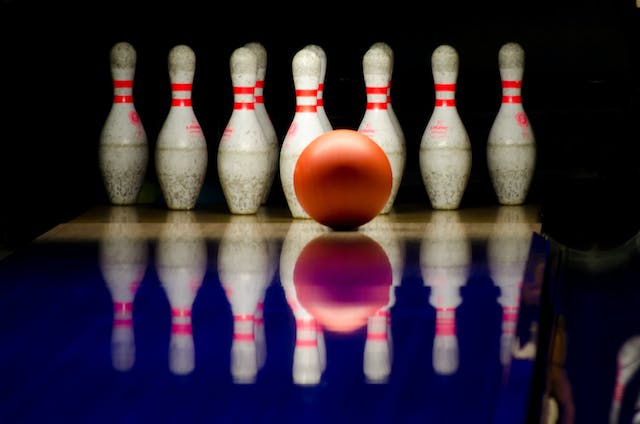
Why are there ten pins in bowling? Because nine pin bowling was outlawed.
Bowling is a very old game because it is a very simple concept. As long as people have a ball and something to throw it at, they can bowl. Balls and pins have been found in a children’s tomb from 5,200 years ago and the game had probably existed for a long time before then. Many countries have a version of bowling where the idea is to get the ball as close as possible to a smaller ball called a jack. The jack is thrown first, so its location is never known. Then points are accrued by being closest. You can knock the opponent’s balls away, in a similar way to curling.
The game we know as ten pin bowling evolved from the German version of the game, called “kegelspiel”. The pins were called “kegel” and there were nine of them, in a diamond shape. The idea was to knock them down, as it is today. The game started in the 3rd or 4th centuries AD and it was played by monks. The monks used a club for self-defense called a kegel. This could be the origin of our word cudgel. The monks balanced these clubs in a diamond shape and threw stones to knock them down. Each kegel was supposed to represent a sin and the monks wanted to knock all of the sins over. Over time, the stones became a ball and the game was played by anybody.
The game appears to have come to England via Denmark or Norway because English people use the word “skittle” to refer to the pins. This probably came from the Norwegian word “skyttel”, which was their word for the pin. Bowling was first mentioned in England in 1366 when King Edward III banned it because it was distracting his troops from practicing archery. Henry VI reversed the ban in 1455.
Bowling probably passed to America via the English, German, Dutch, and Scandinavian people that emigrated there. When bowling started in the US, people used nine pins in a diamond shape and the game was commonly known as “Dutch pins”. 9 pin bowling was the most common and the pins were arranged in the diamond shape that had become common in Europe. It was seen as a working-class game and it became very popular. The first reference to bowling in the US comes from the famous story Rip Van Winkle, by Washington Irving, written in 1819. Rip Van Winkle is woken up by the sound of nine pins being bowled over.
So, why did we go from nine pin bowling to ten pin bowling? It is because of what bowling allies were associated with and a loophole in the system. By the mid 19th century, most bowling alleys were owned by pubs or bars. People would drink while they bowled and the bowling allies became associated with drunkenness and violence. People also gambled on the games and where there is gambling, there is usually organized crime. Bowling obviously wasn’t the problem. It was just a place for the working class to gather and let off steam after working very hard at their jobs. “Respectable” people became afraid of the bowling allies and the people in power moved to ban bowling. The logic was that if they banned bowling, the drunkenness, the gambling, and the organized crime would move away. In 1841, Connecticut banned nine pin bowling. Baltimore and New York appear to have followed suit. Well, you can guess what happened. The smart people who were bowling thought of a loophole. If nine pin bowling was banned, then just add another pin. They added the tenth pin, changed the shape of the pins to a triangle, and ten pin bowling was born.
Bowling started to become more respectable and by the 1850s, different people were trying to work out how to have the pins reset themselves. Most bowling allies used people who stood at the end of each lane to send the ball back down a chute and to reset the pins. By 1875 there was a National Bowling Association and competitions were played. The Brunswick corporation introduced a hard rubber ball in 1905 that was far easier to bowl than the wooden balls that had been used. Bowling allies sprang up everywhere and there was a strong effort to clean up their image and to make them family friendly. The automatic pinsetter was invented in 1936 and it was able to score the game as well. Ten pin bowling was firmly engrained on the culture. And this is what I learned today.
Photo by Skitterphoto: https://www.pexels.com/photo/sport-alley-ball-game-4192/
Sources
https://en.wikipedia.org/wiki/Ten-pin_bowling
https://en.wikipedia.org/wiki/Nine-pin_bowling
https://mega-xtreme.com/en/bowling-history/
https://bowl.com/about-us/history-of-bowling
https://www.topendsports.com/sport/list/skittles.htm
https://www.mastersofgames.com/cat/pub/skittles.htm
https://www.etymonline.com/word/skittles
https://www.thegamebeyond.com/blog/2022/3/22
https://www.bowling.com/bowling-blog/bowling-knowledge/how-the-tenth-pin-changed-bowling-forever/
